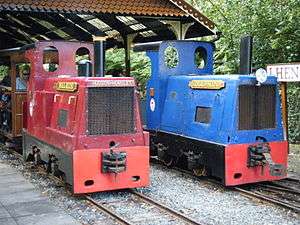Dolphin (locomotive)
 | |||||||||||
| |||||||||||
| |||||||||||
| |||||||||||
| |||||||||||
Dolphin is a diesel locomotive currently based on the Groudle Glen Railway. Dolphin has a sister locomotive Walrus.
Early career
This locomotive was built in 1952 by the Hunslet Engine Company for Robert Hudson, hence the unusual manufacturers' title which appears prominently, cast into the locomotive's radiator frontage. It was built as one of a trio to operate in a sand and gravel pit in Twickenham and upon closure of the pit was put up for sale, together with her two sisters. She, along with one of the other two, was purchased for use on a pleasure railway that was established at Doddington Park in Chipping Sodbury and acquired a "steam outline" structure at this time. This consisted of a sheet metal half-cab with oval windows, false dome and chimney. The exhaust from the engine which had previously been directed beneath the frames was re-routed to be shot from this new chimney to give the appearance that the engine was "steaming" along. The locomotive never carried a name but had the heraldic crests of the country estate on the side panels. By 1980 the park was losing money and closed, the locomotive, her sister, carriages and all trackwork were put up for sale.
To Groudle Glen
When restoration of the Groudle Glen Railway began in 1982 the locomotive (and her sister) were purchased from the park together with all the rails, sleepers and associated pointwork, arriving on the Isle of Man shortly thereafter. In line with previous naming policy (the original locomotives had been named Sea Lion and Polar Bear as these animals were features of the zoo in the glen) the volunteers of the Isle of Man Steam Railway Supporters' Association named the locomotive Dolphin and allocated it the fleet number "1". This was the first time fleet numbers had been given to locomotives on the railway, and curiously it was in fact the other locomotive (given the name Walrus and fleet number "2") that was first on site at the railway. Both locomotives were given a green livery and wooden nameplates, and until the return of Sea Lion in 1987, provided all the motive power for the line's public operations and permanent way trains. The locomotive is retained today and performs shunting duties and winter works train duties regularly.
Notes
This locomotive is identifiable from her sister as she does not carry a false dome (this was removed prior to arrival in the glen), and does not have dummy side tanks. She is also fitted with headlights unlike her shedmate. Other than these visible features she is largely identical to Walrus in all but livery. Having carried the lighter green livery since arrival in 1983, it was in 1992 that she was re-painted into a darker brunswick green shade, then again in 1998 she received an unusual all-over grey livery (including buffers, side frames, cab interior, etc.) but this was short-lived and by the summer of 2001 a further full repaint saw the locomotive outshopped in a royal blue livery. All maintenance is carried out on site and the engine receives annual attention, alternating with Walrus each year. Although now largely relegated to works duties, it does appear in service occasionally as part of gala events each summer, and occasionally for the Santa Trains. It was this locomotive that was renamed Rudolph each yuletide between 1984 and 1997 at which time new nameplates denoting Blitzen were installed. These have, since 2003, been carried by Walrus instead. In 2012 she was stripped down and fully repainted back into her 1980's green livery to mark the 30th Anniversary of the railway's restoration by volunteers, in this guise she hauled public trains on the Special 30th Anniversary day in May. Also in 2012 to mark the locomotives' 60th anniversary, along with her sister, she received new brass nameplates to replace the 1980s wooden nameplates which have subsequently been mounted for display in the Sea Lion Rocks Visitor Centre and the Lhen Coan Engine Shed.
Bibliography
- I.o.M.S.R.S.A. (1966–2009). Manx Steam Railway News. I.o.M.S.R.S.A.
References
- Tony Beard (1994). Groudle Glen Railway: Its History & Restoration. Groudle Glen Railway.
- David Hyland Smith (1989). The Groudle Glen Railway. Brighton: Plateway Press. ISBN 1-871980-00-X.
- Manx Steam Railway News Journal of the Isle of Man Steam Railway Supporters' Association
Coordinates: 54°10′39″N 4°25′19″W / 54.17750°N 4.42194°W